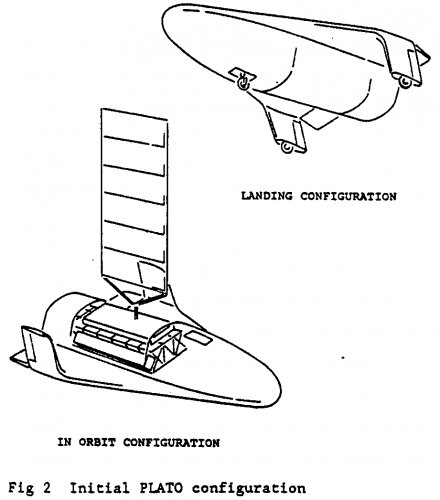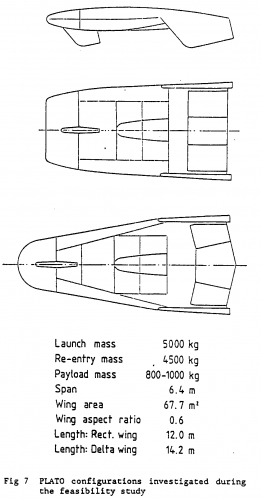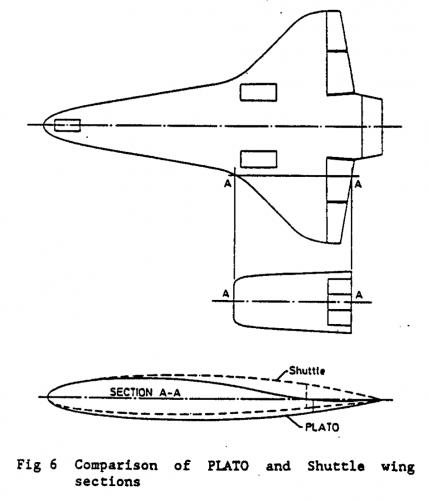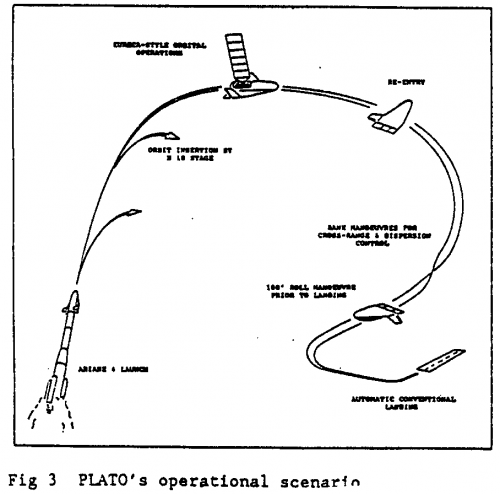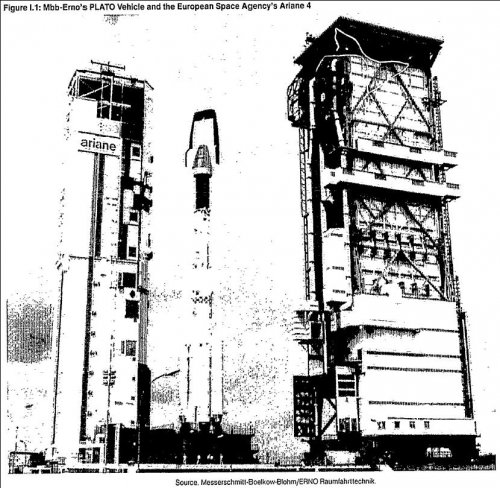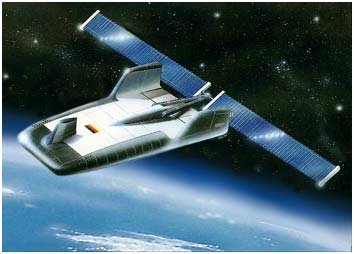martinbayer
ACCESS: Top Secret
- Joined
- 6 January 2009
- Messages
- 3,401
- Reaction score
- 3,909
The recent discussion about HERMES on Ariane 4 triggered a memory of another reusable lifting vehicle planned to be launched by Ariane 4 – the PLATO Platform Orbiter.
The PLATO concept of a small uncrewed winged reentry vehicle was developed by MBB-ERNO in the late Eighties to provide Europe with an autonomous capability to operate ESA’s European Retrievable Carrier (EURECA) independently of the US Space Shuttle. EURECA was a recoverable satellite also designed and built by MBB-ERNO for ESA as a free-flying orbital platform dedicated to microgravity research and solar observation during missions lasting six months or longer, which was to be deployed and retrieved by the Shuttle. After the Challenger accident in 1986, concern grew that other payloads would be given higher priority than EURECA when Shuttle operations resumed, and that opportunities for EURECA type missions would be reduced or even discontinued as a result of the accident. In fact, although EURECA was originally designed to fly up to five times with different experiments, it was launched only once in July 1992 by Atlantis on STS 46 on Atlantis and returned in July 1993 by Endeavor on STS 57, and all following flights were cancelled.
To address the lack of an adequate European launch and retrieval capability for EURECA, PLATO was intended as a completely autonomous European system to accommodate EURECA. EURECA would be integrated into a winged reentry vehicle, which would be launched on an Ariane 4 from Kourou and return to a horizontal landing at a site in southern Europe. Some of EURECA's subsystems, such as power, attitude and orbit control, and communications and data handling, could be used for control of PLATO's return flight. While the original PLATO concept was based on the integration of a full size EURECA platform into a HERMES like vehicle, size constraints associated with the launch on Ariane 44P eventually led to a configuration incorporating roughly one half of the actual EURECA platform.
In addition to the original EURECA mission of conducting conduct materials and life science experiments in orbit as well as performing solar and Earth observation, PLATO’s development objectives were also to develop materials, structures, and navigation and control techniques for future spacecraft. At the same time, design constraints and goals of the PLATO concept development were to keep costs low, to minimize the application of advanced technologies and instead use existing techniques, materials, and components as far as possible to achieve a first operational mission between 1995 and 2000, and to utilize the experience gained during the preparation of EURECA’s first mission and other programs for ground and flight operations.
While the initial PLATO layout was based on a HERMES like wing body configuration, later design iterations switched to flying wing concepts. The first one of these still retained the delta planform derived from Hermes, but the final version had a rectangular wing planform with a very low aspect ratio of 0.6 and a supercritical airfoil. PLATO would have been about 47 feet long in the delta wing configuration respectively 39 feet long in the rectangular wing configuration, and both versions would have had a wingspan of about 21 feet. PLATO would have had a launch mass of about 11 klbs and would have been able to carry a payload of 1.8 to 2.2 klbs.
PLATO's unusual design literally included a unique twist that featured the location of its landing gear in the two rear and single forward vertical fins on top of the vehicle. This layout was chosen to simplify the heat shield design by allowing to avoid breaks and gaps in the TPS for landing gear deployment, but it would have required PLATO to perform a 180 degree roll maneuver after reentry before landing upside down. The original PLATO design had a wheeled landing gear, but concerns regarding the geometric integration of the undercarriage components and the technology development requirements for the wheels and especially the tires led to the implementation of simpler landing skids.
The first step in the PLATO development process was a critical appraisal of its configuration and an assessment of its performance. Phase Al of the PLATO concept feasibility study was conducted between November 1987 and February 1989 for the German Federal Ministry of Research and Technology and focused on obtaining basic design data. It consisted of computer simulations of ascent, reentry, and return flight profiles, preliminary thermal analyses, and a series of low speed wind tunnel tests at the RWTH (Rheinisch-Westfälische Technische Hochschule) University Aachen. The results of the ascent simulations showed that launch of PLATO by an Ariane 4 was feasible. Results from the reentry simulations indicated that PLATO's cross range landing capability would be about 1,240 miles, and that relatively low heat fluxes could be expected, since PLATO would decelerate at high altitude. This would result in low vehicle surface temperatures, which would allow PLATO to be manufactured from less exotic materials. Results of low speed wind tunnel tests indicated that the rectangular wing version of PLATO was the preferred configuration, since it had better aerodynamic characteristics than a delta wing configuration and would be less expensive to build. However, wind tunnel tests at supersonic and hypersonic speeds would still have been required to confirm the superiority of the rectangular wing configuration over the whole flight envelope. In October 1988 MBB-ERNO submitted a proposal for Phase A2 to the German Space Agency to study supersonic aerodynamics, critically analyze all PLATO development stages, and assess its feasibility, but funding never became available, and the PLATO project was stopped.
It is interesting to note that PLATO’s basic concept of a reusable autonomous uncrewed winged reentry vehicle capable of hosting interchangeable payloads in orbit for an extended period of time is essentially identical to that of the X-37, which is planned to make its orbital maiden flight in April 2010.
Sources:
Aerospace Plane Technology, Research and Development Efforts in Europe, pp. 124-128
http://www.dtic.mil/cgi-bin/GetTRDoc?AD=ADA241102&Location=U2&doc=GetTRDoc.pdf
JPRS Report, Science & Technology, Europe: Aerotech 89, pp. 9-18
http://www.dtic.mil/cgi-bin/GetTRDoc?AD=ADA335153&Location=U2&doc=GetTRDoc.pdf
The PLATO concept of a small uncrewed winged reentry vehicle was developed by MBB-ERNO in the late Eighties to provide Europe with an autonomous capability to operate ESA’s European Retrievable Carrier (EURECA) independently of the US Space Shuttle. EURECA was a recoverable satellite also designed and built by MBB-ERNO for ESA as a free-flying orbital platform dedicated to microgravity research and solar observation during missions lasting six months or longer, which was to be deployed and retrieved by the Shuttle. After the Challenger accident in 1986, concern grew that other payloads would be given higher priority than EURECA when Shuttle operations resumed, and that opportunities for EURECA type missions would be reduced or even discontinued as a result of the accident. In fact, although EURECA was originally designed to fly up to five times with different experiments, it was launched only once in July 1992 by Atlantis on STS 46 on Atlantis and returned in July 1993 by Endeavor on STS 57, and all following flights were cancelled.
To address the lack of an adequate European launch and retrieval capability for EURECA, PLATO was intended as a completely autonomous European system to accommodate EURECA. EURECA would be integrated into a winged reentry vehicle, which would be launched on an Ariane 4 from Kourou and return to a horizontal landing at a site in southern Europe. Some of EURECA's subsystems, such as power, attitude and orbit control, and communications and data handling, could be used for control of PLATO's return flight. While the original PLATO concept was based on the integration of a full size EURECA platform into a HERMES like vehicle, size constraints associated with the launch on Ariane 44P eventually led to a configuration incorporating roughly one half of the actual EURECA platform.
In addition to the original EURECA mission of conducting conduct materials and life science experiments in orbit as well as performing solar and Earth observation, PLATO’s development objectives were also to develop materials, structures, and navigation and control techniques for future spacecraft. At the same time, design constraints and goals of the PLATO concept development were to keep costs low, to minimize the application of advanced technologies and instead use existing techniques, materials, and components as far as possible to achieve a first operational mission between 1995 and 2000, and to utilize the experience gained during the preparation of EURECA’s first mission and other programs for ground and flight operations.
While the initial PLATO layout was based on a HERMES like wing body configuration, later design iterations switched to flying wing concepts. The first one of these still retained the delta planform derived from Hermes, but the final version had a rectangular wing planform with a very low aspect ratio of 0.6 and a supercritical airfoil. PLATO would have been about 47 feet long in the delta wing configuration respectively 39 feet long in the rectangular wing configuration, and both versions would have had a wingspan of about 21 feet. PLATO would have had a launch mass of about 11 klbs and would have been able to carry a payload of 1.8 to 2.2 klbs.
PLATO's unusual design literally included a unique twist that featured the location of its landing gear in the two rear and single forward vertical fins on top of the vehicle. This layout was chosen to simplify the heat shield design by allowing to avoid breaks and gaps in the TPS for landing gear deployment, but it would have required PLATO to perform a 180 degree roll maneuver after reentry before landing upside down. The original PLATO design had a wheeled landing gear, but concerns regarding the geometric integration of the undercarriage components and the technology development requirements for the wheels and especially the tires led to the implementation of simpler landing skids.
The first step in the PLATO development process was a critical appraisal of its configuration and an assessment of its performance. Phase Al of the PLATO concept feasibility study was conducted between November 1987 and February 1989 for the German Federal Ministry of Research and Technology and focused on obtaining basic design data. It consisted of computer simulations of ascent, reentry, and return flight profiles, preliminary thermal analyses, and a series of low speed wind tunnel tests at the RWTH (Rheinisch-Westfälische Technische Hochschule) University Aachen. The results of the ascent simulations showed that launch of PLATO by an Ariane 4 was feasible. Results from the reentry simulations indicated that PLATO's cross range landing capability would be about 1,240 miles, and that relatively low heat fluxes could be expected, since PLATO would decelerate at high altitude. This would result in low vehicle surface temperatures, which would allow PLATO to be manufactured from less exotic materials. Results of low speed wind tunnel tests indicated that the rectangular wing version of PLATO was the preferred configuration, since it had better aerodynamic characteristics than a delta wing configuration and would be less expensive to build. However, wind tunnel tests at supersonic and hypersonic speeds would still have been required to confirm the superiority of the rectangular wing configuration over the whole flight envelope. In October 1988 MBB-ERNO submitted a proposal for Phase A2 to the German Space Agency to study supersonic aerodynamics, critically analyze all PLATO development stages, and assess its feasibility, but funding never became available, and the PLATO project was stopped.
It is interesting to note that PLATO’s basic concept of a reusable autonomous uncrewed winged reentry vehicle capable of hosting interchangeable payloads in orbit for an extended period of time is essentially identical to that of the X-37, which is planned to make its orbital maiden flight in April 2010.
Sources:
Aerospace Plane Technology, Research and Development Efforts in Europe, pp. 124-128
http://www.dtic.mil/cgi-bin/GetTRDoc?AD=ADA241102&Location=U2&doc=GetTRDoc.pdf
JPRS Report, Science & Technology, Europe: Aerotech 89, pp. 9-18
http://www.dtic.mil/cgi-bin/GetTRDoc?AD=ADA335153&Location=U2&doc=GetTRDoc.pdf

